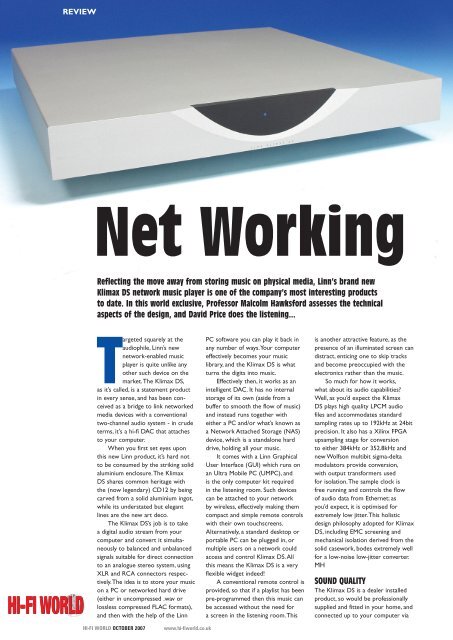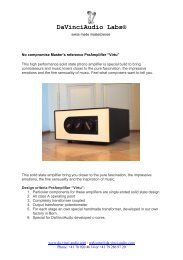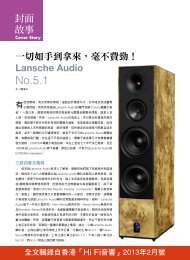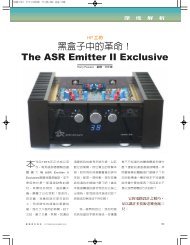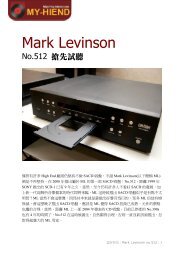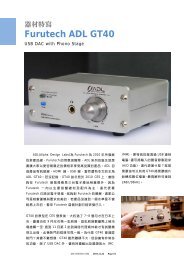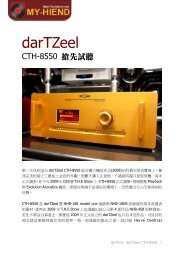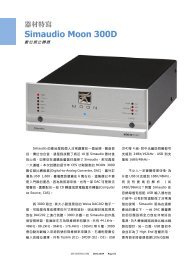Linn Klimax.indd - My Hiend
Linn Klimax.indd - My Hiend
Linn Klimax.indd - My Hiend
You also want an ePaper? Increase the reach of your titles
YUMPU automatically turns print PDFs into web optimized ePapers that Google loves.
REVIEW<br />
Net Working<br />
Reflecting the move away from storing music on physical media, <strong>Linn</strong>’s brand new<br />
<strong>Klimax</strong> DS network music player is one of the company’s most interesting products<br />
to date. In this world exclusive, Professor Malcolm Hawksford assesses the technical<br />
aspects of the design, and David Price does the listening...<br />
HI-FI WORLD<br />
Targeted squarely at the<br />
audiophile, <strong>Linn</strong>’s new<br />
network-enabled music<br />
player is quite unlike any<br />
other such device on the<br />
market. The <strong>Klimax</strong> DS,<br />
as it’s called, is a statement product<br />
in every sense, and has been conceived<br />
as a bridge to link networked<br />
media devices with a conventional<br />
two-channel audio system - in crude<br />
terms, it's a hi-fi DAC that attaches<br />
to your computer.<br />
When you first set eyes upon<br />
this new <strong>Linn</strong> product, it’s hard not<br />
to be consumed by the striking solid<br />
aluminium enclosure. The <strong>Klimax</strong><br />
DS shares common heritage with<br />
the (now legendary) CD12 by being<br />
carved from a solid aluminium ingot,<br />
while its understated but elegant<br />
lines are the new art deco.<br />
The <strong>Klimax</strong> DS’s job is to take<br />
a digital audio stream from your<br />
computer and convert it simultaneously<br />
to balanced and unbalanced<br />
signals suitable for direct connection<br />
to an analogue stereo system, using<br />
XLR and RCA connectors respectively.<br />
The idea is to store your music<br />
on a PC or networked hard drive<br />
(either in uncompressed .wav or<br />
lossless compressed FLAC formats),<br />
and then with the help of the <strong>Linn</strong><br />
HI-FI WORLD OCTOBER 2007<br />
www.hi-fiworld.co.uk<br />
PC software you can play it back in<br />
any number of ways. Your computer<br />
effectively becomes your music<br />
library, and the <strong>Klimax</strong> DS is what<br />
turns the digits into music.<br />
Effectively then, it works as an<br />
intelligent DAC. It has no internal<br />
storage of its own (aside from a<br />
buffer to smooth the flow of music)<br />
and instead runs together with<br />
either a PC and/or what’s known as<br />
a Network Attached Storage (NAS)<br />
device, which is a standalone hard<br />
drive, holding all your music.<br />
It comes with a <strong>Linn</strong> Graphical<br />
User Interface (GUI) which runs on<br />
an Ultra Mobile PC (UMPC), and<br />
is the only computer kit required<br />
in the listening room. Such devices<br />
can be attached to your network<br />
by wireless, effectively making them<br />
compact and simple remote controls<br />
with their own touchscreens.<br />
Alternatively, a standard desktop or<br />
portable PC can be plugged in, or<br />
multiple users on a network could<br />
access and control <strong>Klimax</strong> DS. All<br />
this means the <strong>Klimax</strong> DS is a very<br />
flexible widget indeed!<br />
A conventional remote control is<br />
provided, so that if a playlist has been<br />
pre-programmed then this music can<br />
be accessed without the need for<br />
a screen in the listening room. This<br />
is another attractive feature, as the<br />
presence of an illuminated screen can<br />
distract, enticing one to skip tracks<br />
and become preoccupied with the<br />
electronics rather than the music.<br />
So much for how it works,<br />
what about its audio capabilities<br />
Well, as you’d expect the <strong>Klimax</strong><br />
DS plays high quality LPCM audio<br />
files and accommodates standard<br />
sampling rates up to 192kHz at 24bit<br />
precision. It also has a Xilinx FPGA<br />
upsampling stage for conversion<br />
to either 384kHz or 352.8kHz and<br />
new Wolfson multibit sigma-delta<br />
modulators provide conversion,<br />
with output transformers used<br />
for isolation. The sample clock is<br />
free running and controls the flow<br />
of audio data from Ethernet; as<br />
you’d expect, it is optimised for<br />
extremely low jitter. This holistic<br />
design philosophy adopted for <strong>Klimax</strong><br />
DS, including EMC screening and<br />
mechanical isolation derived from the<br />
solid casework, bodes extremely well<br />
for a low-noise low-jitter converter.<br />
MH<br />
SOUND QUALITY<br />
The <strong>Klimax</strong> DS is a dealer installed<br />
product, so would be professionally<br />
supplied and fitted in your home, and<br />
connected up to your computer via
Ethernet with the supplied <strong>Linn</strong> ‘GUI’<br />
and Twonky media server software. In<br />
my case, I set the <strong>Linn</strong> up via a <strong>Linn</strong>supplied<br />
Toshiba PC, and plugged its<br />
balanced outputs into my reference<br />
MF Audio Silver Passive Preamplifier,<br />
driving a World Audio K5881 tube<br />
amplifier and Yamaha NS1000M<br />
loudspeakers.<br />
The results were deeply<br />
impressive and, spookily, I couldn’t<br />
stop thinking about my year spent<br />
with a Sondek CD12 some time back.<br />
Although the <strong>Klimax</strong> DS and CD12<br />
share little (beautiful aluminium billet<br />
case excepted), <strong>Linn</strong>’s high end digital<br />
products are so meticulously voiced<br />
that – despite the very different<br />
chipsets inside – the two have the<br />
same silky but ultra high resolution<br />
sound that gets into the groove with<br />
the best of them.<br />
With all of my own reference<br />
recordings, committed to the <strong>Linn</strong><br />
PC as .wav files (i.e. uncompressed<br />
16/44 LPCM), I heard a consistently<br />
smooth and well finessed<br />
performance, with an extremely<br />
neutral yet vivid tonality. Bass was<br />
strong and expressive, but in no way<br />
warm or overblown. Midband was<br />
tremendously wide and deep, bristling<br />
with detail and yet never veering<br />
towards stridency, whilst treble<br />
was fine and subtle. The key to the<br />
performance that simply makes me<br />
wish I was playing my vinyl version<br />
of this Blue Note classic, I heard a<br />
smooth, natural, spacious rendition<br />
of the disc, with that lovely ebbing<br />
and flowing rhythm that ‘I Have a<br />
Dream’ sets up. Once again, the<br />
texturality of the instruments was<br />
beautifully carried, with ‘shouty’ brass<br />
instruments such as the trumpet and<br />
fluegelhorn losing none of their feel<br />
but – unusually for digital – gaining<br />
no chromium plating either. Speaking<br />
of metal, the heavily compressed,<br />
noise-addled thrash of Ministry’s<br />
‘Corrosion’ was massively powerful<br />
yet surprisingly listenable – testament<br />
to the <strong>Klimax</strong>’s characteristic ‘iron<br />
fist in a velvet glove’. DP<br />
CONCLUSION<br />
While many British hi-fi manufacturers<br />
have been unstinting in their<br />
condemnation of ‘computer audio’,<br />
<strong>Linn</strong> were an early adopter (the<br />
original Kivor is several years old<br />
already), and have once again done<br />
themselves proud with the <strong>Klimax</strong><br />
DS. Obviously, it’s not a product for<br />
everyone, but to those with large<br />
amounts of digital music stored<br />
on their computers and/or hard<br />
drives (and this number is bound to<br />
increase exponentially over the next<br />
few years as the iPod generation<br />
grow up into real hi-fi), it’s a<br />
landmark product.<br />
Essentially, the first truly high end,<br />
high resolution network music player,<br />
it boasts the company’s trademark<br />
superlative design and build, plus<br />
sonics which are the equal of pretty<br />
much any optical disc player on the<br />
market.<br />
A beautifully engineered, flexible<br />
and superb sounding music playing<br />
device, its biggest problem is simply<br />
the fact that most people won’t<br />
yet understand its reason for being.<br />
Although obvious to ‘early adopting’<br />
digital music devotees, mainstream<br />
audiophiles may struggle to see how<br />
it works and even why it exists in the<br />
first place. Then of course, there's the<br />
price, which is prohibitively expensive<br />
for most people - here's hoping the<br />
technology will 'trickle down' into<br />
more affordable fare.<br />
As the whole world slowly<br />
moves away from ‘physical media’,<br />
there will be more and more<br />
products like <strong>Linn</strong>'s <strong>Klimax</strong> DS, but<br />
this one is special and will continue<br />
to be years later. Whether it's too far<br />
ahead of its time right now, remains<br />
to be seen. DP<br />
[turn to p33 for MEASURED<br />
PERFORMANCE]<br />
REVIEW<br />
HI-FI WORLD<br />
VERDICT<br />
Impeccably engineered, built and voiced,<br />
this is a landmark high end digital<br />
product, but whether it’s too far ahead<br />
of its time is too soon to say.<br />
LINN KLIMAX DS £9,600<br />
<strong>Linn</strong> Products Ltd.<br />
+44 (0)500 888 909<br />
www.linn.co.uk<br />
)<br />
FOR<br />
- state of the art sonics<br />
- superlative build and finish<br />
- concept, flexibility<br />
AGAINST<br />
- price<br />
<strong>Klimax</strong> DS was the way it conveyed<br />
vast amounts of detail and strung it<br />
all together as a coherent and very<br />
emotive musical performance.<br />
With 4hero’s superbly recorded<br />
new album, ‘Play With The Changes’,<br />
I got a tremendously neutral vocal<br />
sound on ‘Give In’. The <strong>Klimax</strong> DS<br />
captured the singer’s voice with<br />
an eerie realism, and intimated his<br />
every subtle inflection. Behind this<br />
was a sumptuous keyboard backing<br />
which the <strong>Linn</strong> again carried with<br />
aplomb, proffering an extremely wide<br />
soundstage that hung back more<br />
than I’d heard with CD to date. The<br />
<strong>Klimax</strong> provided razor-sharp timing,<br />
as evinced by the giddying attack of<br />
hi-hat cymbals.<br />
Herbie Hancock’s ‘The Prisoner’<br />
was also unrecognisably ‘analogue’<br />
sounding, the <strong>Klimax</strong> DS giving no<br />
clues that it was [a] digital and [b]<br />
using a Toshiba PC’s hard drive as a<br />
source! Instead of the usual stilted<br />
SECOND THOUGHTS<br />
I installed the new <strong>Klimax</strong> DS as the front end of my reference system. <strong>Linn</strong> supplied me with a<br />
Dell PC (so I didn’t need to set up my own), which came with a number of high resolution tracks<br />
pre-loaded (after all, the unit will sing all the way to 192kHz sampling) but I also installed some<br />
additional tracks including some high quality Chinese recordings which I had discovered on a<br />
recent trip to Singapore. (Believe me, some of these CDs put to shame many of the factory-studio<br />
discs we see in the West - the recordings are mastered in DSD, employ high-quality electronics and<br />
microphones and use simple techniques with little or no compression). Replay equipment included<br />
Audio Physic Tempo loudspeakers with two muRata supertweeters atop each one, LFD power<br />
amplification and a digitally controlled analogue gain stage. Normally my system incorporates an<br />
LFD DAC3 preceded by a dCS sampling-rate converter to filter source jitter. Audition commenced in<br />
a darkened room to reduce cross-sense contamination, first by sampling the hi-res <strong>Linn</strong> tracks and<br />
then moving to familiar CD recordings.<br />
It was obvious that the <strong>Klimax</strong> DS occupied rarefied and esoteric sonic territory, as I don’t<br />
think I’ve ever heard better from a digital source. The results were magical, and it was immediately<br />
evident that the performance had risen significantly above my in-house reference converter, itself<br />
capable of superb clarity. The stereo soundstage proved truly capacious, giving a wonderful sense<br />
of envelopment, and transients were fast and totally devoid of grain, edge or smear. Vocals had<br />
stunning presence and immediacy, and overall the sound texture was delicate, natural and beautifully<br />
reproduced. As the music faded at the end of a track, it seemed to reach out and touch infinity,<br />
such was the clarity and low level signal integrity of this machine. Although the supplied 24/192<br />
recordings proved wonderfully realistic, fast and articulate with a lush, shimmering metallic quality<br />
to percussion, what really surprised me was how well the <strong>Klimax</strong> DS did with plain old 16/44.1.<br />
The sound was a revelation, but I just wish it hadn’t taken over thirty years to get here – all those<br />
wasted hours! MH<br />
www.hi-fiworld.co.uk OCTOBER 2007 HI-FI WORLD
HI-FI WORLD<br />
Jitter is a barometer of the effectiveness<br />
of any digital audio system design - ideally<br />
there should only be a small amount of<br />
narrowband random jitter, as this is least<br />
damaging sonically. So to measure the<br />
<strong>Klimax</strong> DS’s jitter, I used a high-amplitude,<br />
high-frequency input signal together with an<br />
analysis technique capable of fine spectral<br />
resolution, and noise averaging to expose<br />
any coherent jitter sidebands. <strong>My</strong> selected<br />
test signal was a maximum amplitude sine<br />
wave set at one quarter the sampling rate<br />
(i.e. 24kHz for a 96kHz sampling rate). This<br />
signal was computed over 221 samples<br />
and gives a spectral resolution of 0.046Hz,<br />
then loaded into a PC, streamed to <strong>Klimax</strong><br />
DS and subsequently recaptured by a highperformance<br />
analogue to digital convertor.<br />
The results proved very impressive – the<br />
spectrum in figure 1 is extremely clean, and<br />
consists mainly of noise extending about<br />
10Hz either side of the excitation frequency.<br />
Although predominantly contained within a<br />
1Hz bandwidth, there are some minor spectral<br />
lines just evident above the noise, which I<br />
should think are benign and just as likely to<br />
be related to the ADC clock - no measurement<br />
instrument is perfect!<br />
The next measurement, again performed<br />
at 96kHz, used a 221 sample noise sequence<br />
equalised for a flat amplitude spectrum.<br />
The frequency response is shown in Figure<br />
2, while Figure 3 shows the interchannel<br />
crosstalk. These show the new <strong>Linn</strong> has<br />
a well extended low frequency response,<br />
with the -3dB break frequency at about<br />
1Hz. However, at high frequency there’s an<br />
apparent 0.7dB peak in the response at about<br />
35kHz - just before the high-frequency lowpass<br />
filters kick in. I was initially concerned,<br />
but it was found to be a function of ADC<br />
loading and the mildly inductive output<br />
impedance of the transformers. As you can<br />
see in Figure 4, where the error disappears, a<br />
preamplifier offers a kinder load.<br />
When I did the jitter test, I found there<br />
were narrow band sidebands distributed<br />
around the test frequency. Now, when an<br />
equalised noise excitation is used, this<br />
actually consists of series of closely spaced<br />
sine waves having random phase, so if you<br />
imagine similar noise sidebands about each<br />
of these components. Because the lines are<br />
so close, the result is noise in the measured<br />
frequency response. Also, because there are<br />
now multiple tones, any non-linearity in the<br />
system will add intermodulation products to<br />
the output. By first smoothing the frequency<br />
response, distortion in the spectrum can be<br />
estimated, and in Figure 5a both frequency<br />
response (top) and spectral error function<br />
(bottom) are shown. The total error in<br />
each spectral line from sideband noise and<br />
intermodulation is around 80dB. Given the<br />
0.046Hz line spacing, this is an excellent<br />
result - especially as both DAC and ADC<br />
errors contribute, so the <strong>Klimax</strong> DS must<br />
actually be a little better than this result<br />
suggests.<br />
Increasing the line spacing to 100Hz,<br />
sideband noise due principally to jitter is<br />
reduced and the frequency response error<br />
then falls to below 100dB as shown in Figure<br />
5b, while in Figure 5c the noise between the<br />
spectral lines can be seen to have fallen to<br />
MEASURED PERFORMANCE<br />
the noise floor. Obviously, any practical 24bit<br />
digital system is going to have a noise floor<br />
significantly above the theoretical level (see<br />
red traces where appropriate). The noise<br />
spectrum was measured both with <strong>Klimax</strong><br />
DS switched on and off, and as there was<br />
only a tiny perceptible difference in the<br />
measurements, this shows the <strong>Linn</strong> has lower<br />
noise than the measuring analogue to digital<br />
convertor!<br />
In further tests, sparse low-level line<br />
spectra (around -140dB) were observed,<br />
which are very likely to be interference from<br />
a nearby PC and very difficult to eliminate in<br />
practice – again this is no reflection on the<br />
<strong>Klimax</strong> DS. These very low-level artefacts<br />
become visible when extending resolution to<br />
24bit, which in practice is about 4 to 6bits<br />
greater than what’s really needed for high<br />
quality audio. (Just because a system has<br />
24bit resolution does not imply accuracy to<br />
24bit, and this goes for both recording and<br />
reproduction systems.)<br />
Overall, these measurements show that<br />
<strong>Linn</strong>’s new <strong>Klimax</strong> DS is doing a fine job in<br />
terms of signal conversion - there’s very<br />
little to criticise, which is just how it should<br />
be. Given the clean jitter waveform and low<br />
distortion, I’d expect a neutral and accurate<br />
sonic performance. Low distortion and jitter<br />
bode well for what I euphemistically call the<br />
'signal-to-grunge ratio', which often pervades<br />
lesser equipment and is the principal reason<br />
why perceived dynamic range and clarity are<br />
often less than might be expected from basic<br />
frequency response and noise measurements<br />
- engineering this out is what master-class<br />
level electronic design is all about. <strong>Klimax</strong><br />
DS ticks all the right boxes and I have little<br />
to criticise in terms of design ethos, its<br />
execution and electronic performance. MH<br />
Figure 1 Jitter spectrum zoomed in<br />
to 24 kHz excitation signal.<br />
Figure 2 Frequency response, output<br />
loaded by ADC.<br />
REVIEW<br />
Figure 3 Inter-channel (crosstalk)<br />
frequency response difference.<br />
Figure 4 Frequency response with<br />
minimal output loading.<br />
Figure 5a Frequency response and<br />
error function, 0.046 Hz line spacing.<br />
Figure 5b Frequency response and<br />
error function, 100 Hz guard bands.<br />
Figure 5c Output spectrum, 100 Hz<br />
guard bands (observe noise floor<br />
between lines).<br />
www.hi-fiworld.co.uk OCTOBER 2007 HI-FI WORLD


